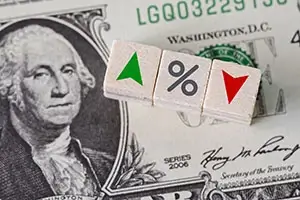
The Federal Reserve’s September interest rate hike marks the fifth straight increase in 2022. What does that mean for the mortgage world?
Fed Rate Hikes
The Federal Reserve is in charge of maintaining a healthy level of inflation and employment in the U.S. One of the main tools at their disposal to alter these levels is the federal funds rate, or the rate that banks charge each other to borrow or lend excess reserves overnight. The Fed can raise the rate to slow inflation or lower it to encourage more economic growth. The federal funds rate was dropped to the 0%-0.25% range in July 2020 as the COVID-19 pandemic started starving the economy.
However, by the end of the 2021 high demand for products and shorter supply started to push inflation up quickly, with the official U.S. inflation rate reaching a high of 9.1% in June 2022 (the Fed likes to keep inflation at roughly 2% annually.) To combat the growth, the Fed exercised its economic muscle with a one-quarter percentage point increase to the federal funds rate in March 2022, followed by an identical raise in May. In June, it took the dramatic step of increasing it by three-quarters of a percentage point, which was the largest Fed rate hike since 1994. The Fed raised the rate another three-quarters percentage point in July, and now again September. That puts the federal funds rate in the range of 3.0% - 3.25%, the lowest level since 2008 when the economy was reeling from the housing crash and subsequent Great Recession. And the last time the Fed increased rates this many times in a year was back in the 1980s when national inflation had hit 15%.
How Fed Rates Affect Mortgage Rates
The federal funds rate does not have a direct impact on mortgage rates. Mortgage interest rates tend to track more closely with the 10-year Treasury bond yields. However, the Fed’s rate does influence the basic direction of all other market rates. If it is more expensive for lenders to borrow from each other, they will pass on the costs to their customers, raising their own lending rates. Mortgage lenders and investors also watch the Fed’s movements closely to see what direction the economy is headed. When the Fed raises interest rates, mortgage interest rates will often see an increase as well.
How the Mortgage Market is Responding
Mortgage interest rates on 30-year fixed-rate loans have more than doubled since the end of 2021, meaning monthly mortgage costs are now 28% higher than they were a year ago. That means potential home buyers have one-third less buying power than they did last year, a fact that has been causing many borrowers to sit back on the market sidelines. Home sales and prices have been slowing and inventory has increased incrementally.
How To Buy or Refinance with Rising Rates
That is good news for home buyers with large down payments and strong incomes, but for first-time buyers the higher interest rates may negate the slowing price growth.
In today’s financial climate, those looking to buy might need to downsize their wish list in terms of property size or condition to be able to afford a home at higher rates. Making larger down payments, shortening the loan term, or paying more discount points can all help lower the loan interest rate on a mortgage. Considering an ARM loan might help first-timers break into the market with lower introductory rates, as long as they have a plan to refinance or sell before the payments increase. And borrowers with poor credit might do better to take time to improve their score before applying for mortgage funding at high rates.
Even though the Fed has promised to raise rates another two times, history shows that even at higher interest rates Americans are able to buy homes and move forward with their life goals. Borrowers just need to be smart about their buying and refinancing strategies.
These materials are not from HUD or FHA and were not approved by HUD or a government agency.

